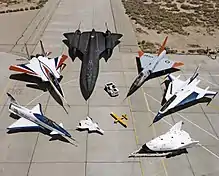List of military aircraft of the United States
This list of military aircraft of the United States includes prototype, pre-production, and operational types. For aircraft in service, see the list of active United States military aircraft. Prototypes are normally prefixed with "X" and are often unnamed (note that these are not the same as the experimental X-planes, which are not generally expected to go into production), while pre-production models are usually prefixed with "Y".
| United States military aircraft |
|---|
|
The United States military employs a designation and naming system to provide identifications to all aircraft types. Until 1962, the United States Army, United States Air Force (formerly Army Air Force), and United States Navy all maintained separate systems. In September 1962,[1] these were unified into a single system heavily reflecting the Air Force method. For more complete information on the workings of this system, refer to United States Department of Defense Aerospace Vehicle Designations.
This list does not include aircraft used by the U.S. military services prior to the establishment of a numerical designation system. For these aircraft, see List of military aircraft of the United States (1909–1919). It also does not include aircraft designated under the pre-1962 United States Navy designation system. For these aircraft, see List of military aircraft of the United States (naval).
Prior to 1919
Prior to 1919, all planes flown by the Army Air Service and the Navy were referred to by the designation given to them by their manufacturer. A variety of both domestic and foreign types were operated, with the latter being the primary front-line types during the First World War.
Army Air Service, 1919–1924
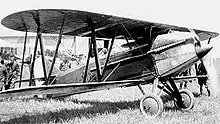
In September 1919, the Army Air Service decided that it needed an organized designation sequence, and adopted fifteen classifications, designated by Roman numerals. Several other unnumbered designations were added later. Each designation was assigned an abbreviation, and each design a number within that abbreviation. Variants were designated by alphabetically appending letters to the design number.
Type O: Foreign-Built Pursuit Aircraft
- Fokker D.VII – Fokker
- Fokker D.VIII – Fokker
Type I: Pursuit, water-cooled
Type II: Pursuit, night
- PN-1 – Curtiss
Type III: Pursuit, air-cooled
- PA-1 – Loening
Type IV: Pursuit, ground attack, 1922
Type V: Two-seat pursuit
- TP-1 – Engineering Division
Type VII: Infantry liaison
- IL-1 – Orenco
Type X: Corps observation
Type XI: Day bombardment
- DB-1 – Gallaudet
Type XII: Night bombardment, short range
- NBS-1 – Martin (originally designated MB-2)
- NBS-2 – Lowe-Willard-Fowler
- NBS-3 – Elias
- NBS-4 – Curtiss
Type XIV: Trainer, air-cooled
- TA-1 – Elias
- TA-2 – Huff-Daland
- TA-3 – Dayton-Wright Aircraft
- TA-4 – Engineering Division
- TA-5 – Dayton-Wright Aircraft
- TA-6 – Huff-Daland
Type XV: Trainer, water-cooled
Pursuit, special
- PS-1 – Dayton-Wright
Racer

Seaplane
- S-1 – Loening
Transport
- T-1 – Martin
- T-2 – Fokker
- T-3 – Lowe-Willard-Fowler
Lighter-than-air craft
- AC-1 — designed for "long flights and cross-country work", this was a 169 foot long, 180,000 cubic foot buoyancy craft which had one of its earliest long flights in May 1923.[2]
- RN-1 — designated "Zodiac", this was a semi-rigid dirigible, 262.5 feet long with a 360,000 cubic foot buoyancy volume.[3]
Army Air Corps/Army Air Forces/Air Force 1924–1962
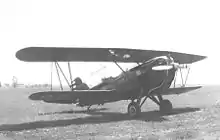
Attack, 1924–1948
- A-1 – skipped to prevent confusion with Cox-Klemin XA-1
- A-2 – Douglas
- A-3 Falcon – Curtiss
- A-4 Falcon – Curtiss
- A-5 Falcon – Curtiss
- A-6 Falcon – Curtiss
- A-7 – Fokker
- A-8 – Curtiss
- A-9 – Lockheed
- A-10 Shrike – Curtiss
- A-11 – Consolidated
- A-12 Shrike – Curtiss
- A-13 – Northrop
- A-14 – Curtiss
- A-15 – Martin
- A-16 – Northrop
- A-17 Nomad – Northrop
- A-18 Shrike – Curtiss
- A-19 – Vultee
- A-20 Havoc – Douglas (redesignated as B-20 in 1948)
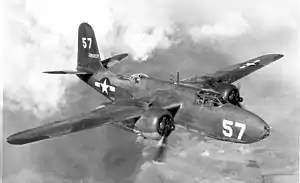 A-20 Havoc
A-20 Havoc - A-21 – Stearman
- A-22 – Martin (assigned but none served with AAF)
- A-23 Baltimore – Martin
- A-24 Banshee – Douglas (redesignated as F-24 in 1948)
- A-25 Shrike – Curtiss
- A-26 Invader – Douglas (redesignated as B-26 in 1948, then as A-26 in 1966)
- A-27 – North American
- A-28 Hudson – Lockheed
- A-29 Hudson – Lockheed
- A-30 – Martin (assigned to allow supply to the UK under Lend-lease)
- A-31 Vengeance – Vultee
- A-32 – Brewster
- A-33 – Douglas
- A-34 – Brewster
- A-35 Vengeance – Vultee
- A-36 Apache/Invader – North American
- A-37 – Hughes
- A-38 Grizzly – Beechcraft
- A-39 – Kaiser-Fleetwings
- A-40 – Curtiss
- A-41 – Vultee
- A-42 Mixmaster – Douglas
- A-43 Blackhawk – Curtiss-Wright
- A-44 – Convair
- A-45 – Martin
Bomber
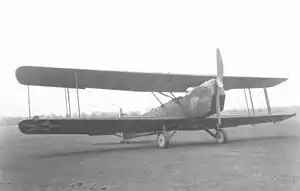
Until 1926, the Army Air Service had three sequences for bombers. Light bombers were indicated by the LB- prefix, medium bombers by the B- prefix, and heavy bombers by the HB- prefix. In 1926, the three-category system was scrapped and all bombers subsequently built were placed in the B- sequence.
Light Bomber, 1924–1926
- LB-1 – Huff-Daland (later Keystone)
- LB-2 – Atlantic Aircraft Corporation (Fokker Aircraft Corp after 1925)
- LB-3 – Keystone
- Martin LB-4 – serial number assigned but prototype not built
- LB-5 – Keystone
- LB-6 – Keystone
- LB-7 – Keystone
- LB-8 – Keystone
- LB-9 – Keystone
- LB-10 – Keystone
- LB-11 – Keystone
- LB-12 – Keystone
- LB-13 – Keystone
- LB-14 – Keystone
Medium Bomber, 1924–1926
- B-1 – Huff-Daland
- B-2 Condor – Curtiss
Unified bomber sequence, 1926–1962
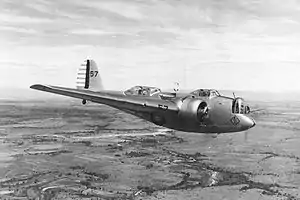
- B-1 – Huff-Daland/Keystone
- B-2 Condor – Curtiss
- B-3 – Keystone
- B-4 – Keystone
- B-5 – Keystone
- B-6 – Keystone
- B-7 – Douglas
- B-8 – Fokker
- B-9 – Boeing
- B-10 – Martin
- B-11 – Douglas
- B-12 – Martin
- B-13 – Martin
- B-14 – Martin
- B-15 – Boeing (XB-15 Prototype)
- B-16 – Martin
- B-17 Flying Fortress – Boeing
- B-18 Bolo – Douglas
- B-19 – Douglas
- B-20 – Boeing
- B-20 Havoc – Douglas (designation of A-20 Havoc from 1948 to 1949)
- B-21 – North American
- B-22 – Douglas
- B-23 Dragon – Douglas
- B-24 Liberator – Consolidated
 B-24 Liberator
B-24 Liberator - B-25 Mitchell – North American
- B-26 Marauder – Martin
- B-26 Invader – Douglas – designation of A-26 Invader from 1948 to 1966
- B-27 – Martin
- B-28 Dragon – North American
- B-29 Superfortress – Boeing
- B-30 – Lockheed
- B-31 – Douglas
- B-32 Dominator – Consolidated
- B-33 Super Marauder – Martin
- B-34 Lexington – Lockheed
- B-35 – Northrop
- B-36 Peacemaker – Convair
- B-37 – Lockheed
- B-38 Flying Fortress – Boeing
- B-39 Superfortress – Boeing
- B-40 Flying Fortress – Boeing
- B-41 Liberator – Consolidated
- B-42 Mixmaster – Douglas
- B-43 Jetmaster – Douglas
- B-44 Superfortress – Boeing
- B-45 Tornado – North American
- B-46 – Convair
- B-47 Stratojet – Boeing
- B-48 – Martin
- B-49 – Northrop
- B-50 Superfortress – Boeing
- B-51 – Martin
- B-52 Stratofortress – Boeing
_in_flight_061127-F-1234S-026.jpg.webp) JB-52E Stratofortress
JB-52E Stratofortress - B-53 – Convair
- B-54 – Boeing
- B-55 – Boeing
- B-56 – Boeing
- B-57 Canberra – Martin
- B-58 Hustler – Convair
- B-59 – Boeing
- B-60 – Convair
- B-61 Matador – Martin (redesignated as TM-61, then MGM-1)
- B-62 Snark – Northrop (redesignated as SM-62)
- B-63 RASCAL – Bell (redesignated as GAM-63)
- B-64 Navaho – North American (redesignated as SM-64)
- B-65 Atlas – Convair (redesignated as SM-65)
- B-66 Destroyer – Douglas
- B-67 Crossbow – Radioplane (redesignated as GAM-67)
- B-68 – Martin
- B-68 Titan – Martin (redesignated as SM-68)
- B-69 Neptune – Lockheed
- B-70 Valkyrie – North American
- B-71 Blackbird – Lockheed[4]
- Beginning with #69, the "M-" (missile) and "B-" (bomber) series diverged. The missiles designated M-69 to M-92, some of which are incorrectly labeled as "formerly designated B-xx" in some sources, never used a "B-" series designation.
Bomber, long range, 1935–1936
A short-lived designation used from 1935–1936 to refer to three long-range bomber projects commissioned by the Army Air Corps. Most of the bombers were night bombers.
Cargo, 1924–1962
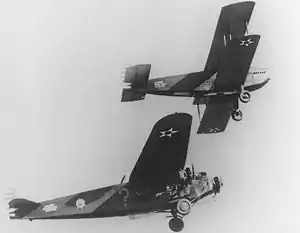
- C-1 – Douglas
- C-2 – Fokker
- C-3 – Ford
- C-4 – Ford
- C-5 – Fokker
- C-6 – Sikorsky
- C-7 – Fokker
- C-8 – Fairchild
- C-9 – Ford
- C-10 Robin – Curtiss-Wright
- C-11 Fleetster – Consolidated
- C-12 Vega – Lockheed
- C-13 – not used
- C-14 – Fokker
- C-15 – Fokker
- C-16 – Fokker
- C-17 Super Vega – Lockheed
- C-18 Monomail – Boeing
- C-19 Alpha – Northrop
- C-20 – Fokker
- C-21 Dolphin – Douglas
- C-22 Fleetster – Consolidated
- C-23 Altair – Lockheed
- C-24 – American/Fairchild
- C-25 Altair – Lockheed
- C-26 Dolphin – Douglas
- C-27 Airbus – Bellanca
- C-28 – Sikorsky
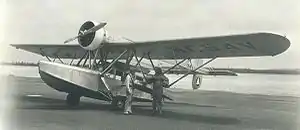 Sikorsky C-28
Sikorsky C-28 - C-29 Dolphin – Douglas
- C-30 Condor – Curtiss-Wright
- C-31 – Kreider-Reisner
- C-32 – Douglas
- C-33 – Douglas
- C-34 – Douglas
- C-35 Electra – Lockheed
- C-36 Electra – Lockheed
- C-37 Electra – Lockheed
- C-38 – Douglas
- C-39 – Douglas
- C-40 Electra – Lockheed
- C-41 – Douglas
- C-42 – Douglas
- C-43 Traveller – Beechcraft
- C-44 – Messerschmitt
- C-45 Expeditor – Beechcraft
- C-46 Commando – Curtiss-Wright
- C-47 Skytrain – Douglas
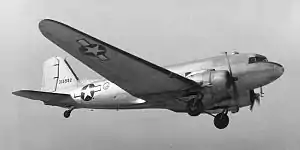 C-47 Skytrain
C-47 Skytrain - C-48 Skytrain – Douglas
- C-49 Skytrain – Douglas
- C-50 Skytrain – Douglas
- C-51 Skytrain – Douglas
- C-52 Skytrain – Douglas
- C-53 Skytrooper – Douglas
- C-54 Skymaster – Douglas
- C-55 Commando – Curtiss-Wright
- C-56 Lodestar – Lockheed
- C-57 Lodestar – Lockheed
- C-58 Bolo – Douglas
- C-59 Lodestar – Lockheed
- C-60 Lodestar – Lockheed
- C-61 Forwarder – Fairchild
- C-62 – Waco
- C-63 Hudson – Lockheed
- C-64 Norseman – Noorduyn
- C-65 Skycar – Stout
- C-66 Lodestar – Lockheed
- C-67 Dragon – Douglas
- C-68 – Douglas
- C-69 Constellation – Lockheed
- C-70 Nightingale – Howard
- C-71 Executive – Spartan
- C-72 – Waco
- C-73 – Boeing
- C-74 Globemaster – Douglas
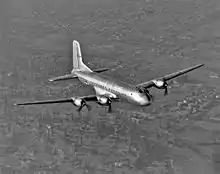 C-74 Globemaster
C-74 Globemaster - C-75 – Boeing
- C-76 Caravan – Curtiss-Wright
- C-77 – Cessna
- C-78 Bobcat – Cessna
- C-79 – Junkers
- C-80 – Harlow
- C-81 Reliant – Stinson
- C-82 Packet – Fairchild
- C-83 Coupe – Piper
- C-84 – Douglas
- C-85 Orion – Lockheed
- C-86 Forwarder – Fairchild
- C-87 Liberator Express – Consolidated
- C-88 – Fairchild
- C-89 – Hamilton
- C-90 – Luscombe
- C-91 – Stinson
- C-92 – Akron-Funk
- C-93 Conestoga – Budd
- C-94 – Cessna
- C-95 Grasshopper – Taylorcraft
- C-96 – Fairchild
- C-97 Stratofreighter – Boeing
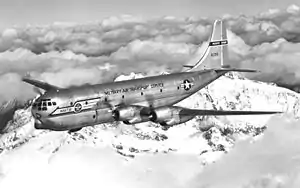 C-97 Stratofreighter
C-97 Stratofreighter- KC-97 Stratofreighter – Boeing
- C-98 Clipper – Boeing
- C-99 – Convair
- C-100 Gamma – Northrop
- C-101 Vega – Lockheed
- C-102 Sportster – Rearwin
- C-103 – Grumman
- C-104 – Lockheed
- C-105 – Boeing
- C-106 – Cessna
- C-107 Skycar – Stout
- C-108 Flying Fortress – Boeing
- C-109 Liberator Express – Consolidated
- C-110 – Douglas
- C-111 Super Electra – Lockheed
- C-112 – Douglas
- C-113 Commando – Curtiss-Wright
- C-114 Skymaster – Douglas
- C-115 Skymaster – Douglas
- C-116 Skymaster – Douglas
- C-117 Super Skytrain – Douglas
- C-118 Liftmaster – Douglas
- C-119 Flying Boxcar – Fairchild
- C-120 Packplane – Fairchild
- C-121 Constellation – Lockheed
- YC-121F Constellation – Lockheed
- C-122 Avitruc – Chase
- C-123 Provider – Fairchild
- XC-123A – Chase
- C-124 Globemaster II – Douglas
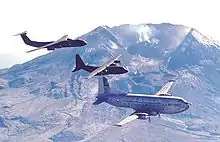 From left to right: C-141, C-130, and C-124 with Mount St. Helens in the background
From left to right: C-141, C-130, and C-124 with Mount St. Helens in the background - C-125 Raider – Northrop
- C-126 – Cessna
- C-127 – Douglas
- C-128 Flying Boxcar – Fairchild
- C-129 Super Skytrain – Douglas
- C-130 Hercules – Lockheed
- C-131 Samaritan – Convair
- C-132 – Douglas
- C-133 Cargomaster – Douglas
- C-134 – Stroukoff
- C-135 Stratolifter – Boeing
- KC-135 Stratotanker – Boeing
- C-136 – Fairchild
- C-137 Stratoliner – Boeing
- C-138 – reserved for Fokker F27, but never assigned
- C-139 – Lockheed
- C-140 Jetstar – Lockheed
- C-141 Starlifter – Lockheed
- C-142 – Vought
- C-143 – reserved for what would become the X-19, but never officially assigned
1922–1935
- GL-1 Unmanned Coastal Artillery Target Glider - McCook Field Engineering Section
- GL-2 Manned Aerial Target Glider - McCook Field Engineering Section
- GL-3 Unmanned Aerial Target Glider (also known as "G-3") - McCook Field Engineering Section
1940–1941
- A-1 – Fleetwings
- A-2 – Radioplane
- A-3 – Curtiss
- A-4 – Douglas
- A-5 – Boeing
- A-6 – Douglas
- A-7 Airacobra – Bell
- A-8 Cadet – Culver
1942–1948
- PQ-8 Cadet – Culver
- PQ-9 – Culver
- PQ-10 – Culver
- PQ-11 – Fletcher
- PQ-12 – Fleetwings
- PQ-13 – ERCO
- PQ-14 Cadet – Culver
- PQ-15 – Culver
Aerial Target (Model Airplane), 1942–1948

Controllable bomb, 1942–1945
- BQ-1 – Fleetwings
- BQ-2 – Kaiser-Fleetwings
- BQ-3 – Fairchild
- BQ-4 – Interstate
- BQ-5 – Interstate
- BQ-6 – Interstate
- BQ-7 Flying Fortress – Boeing
- BQ-8 Liberator – Consolidated[5]
Target Control, 1942–1948
- CQ-1 – Fletcher
- CQ-2 – Stinson
- CQ-3 Expeditor – Beechcraft
- CQ-4 Flying Fortress – Boeing
Unified sequence, 1948–1962
- Q-1 – Radioplane
- Q-2 Firebee – Ryan
- Q-3 – Radioplane
- Q-4 – Northrop
- Q-5 Kingfisher – Lockheed
- Q-6 – Wright Air Development Center
- Q-7 – skipped: request for redesignation of QB-17 not approved
- Q-8 Cadet Culver
- Q-8 – request for redesignation of QF-80 not approved
- Q-9 – WADC
- Q-10 – Radioplane
- Q-11 – WADC
- Q-12 – Beechcraft
- Q-14 Cadet – Culver
Cargo Glider, 1941–1948

- CG-1 – Frankfort
- CG-2 – Frankfort
- CG-3 – Waco
- CG-4 Hadrian – Waco
- CG-5 – St. Louis
- CG-6 – St. Louis
- CG-7 – Bowlus-DuPont/Douglas
- CG-8 – Bowlus-DuPont/Douglas
- CG-9 – AGA Aviation
- CG-10 Trojan Horse – Laister-Kauffman
- CG-11 – Snead
- CG-12 – Read-York
- CG-13 – Waco
- CG-14 – Chase
- CG-15 Hadrian – Waco
- CG-16 – General Airborne Transport
- CG-17 – Douglas
- CG-18 – Chase
- CG-19 – Douglas
- CG-20 – Chase
Fuel Glider, 1930–1948
- FG-1 – Cornelius
Training Glider, 1941–1948
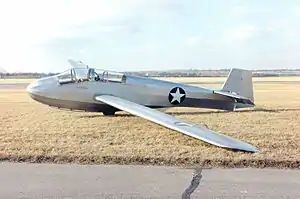
- TG-1 – Frankfort
- TG-2 – Schweizer
- TG-3 – Schweizer
- TG-4 – Laister-Kauffman
- TG-5 Grasshopper – Aeronca
- TG-6 Grasshopper – Taylorcraft
- TG-7 Orlik – Kocjan
- TG-8 Grasshopper – Piper
- TG-9 – Briegleb
- TG-10 – Wichita Engineering
- TG-11 – Schempp-Hirth
- TG-12 – Bowlus-DuPont
- TG-13 – Briegleb
- TG-14 – Stiglmeier
- TG-15 – Franklin-Stevens
- TG-16 – Schultz
- TG-17 – Franklin
- TG-18 – Midwest Sailplane
- TG-19 – Jacobs-Schweyer
- TG-20 – Laister-Kauffman
- TG-21 – Notre Dame
- TG-22 – Mehlhose
- TG-23 – Harper-Corcoran
- TG-24 – Bowlus-Dupont
- TG-25 Plover – Wolcott
- TG-26 – Universal
- TG-27 – Schneider
- TG-28 Hawk Junior – Haller
- TG-29 – Volmer Jensen
- TG-30 Bluebird – Smith
- TG-31 – Aero Industries
- TG-32 – Pratt-Read
- TG-33 – Aeronca
Unified sequence, 1948–1955
- G-2 – Ridgefield
- G-3 – Waco
- G-4 Hadrian – Waco
- G-10 Trojan Horse – Laister-Kauffman
- G-13 – Waco
- G-14 – Chase
- G-15 Hadrian – Waco
- G-18 – Chase
- G-20 – Chase
Sailplane, 1960–1962
- S-1 – Schweizer
- S-2 – Schweizer
Liaison, 1942–1962
- L-1 Vigilant – Stinson
- L-2 Grasshopper – Taylorcraft
- L-3 Grasshopper – Aeronca
- L-4 Grasshopper – Piper
- L-5 Sentinel – Stinson (redesignated as U-19 in 1962)
- L-6 Grasshopper – Interstate
- L-7 – Universal
- L-8 Cadet – Interstate
- L-9 – Stinson
- L-10 – Ryan
- L-11 – Bellanca
- L-12 Reliant – Stinson
- L-13 – Stinson/Convair
- L-14 Cub – Piper
- L-15 Scout – Boeing
- L-16 Champion – Aeronca
- L-17 Navion – North American/Ryan (redesignated as U-18 in 1962)
- L-18 Super Cub – Piper
- L-19 Bird Dog – Cessna (redesignated as O-1 in 1962)
- L-20 Beaver – de Havilland Canada (redesignated as U-6 in 1962)
- L-21 Super Cub – Piper (redesignated as U-7 in 1962)
- L-22 Navion – Ryan
- L-23 Seminole – Beechcraft (redesignated as U-8 in 1962)
- L-24 Courier – Helio (redesignated as U-24 in 1962)
- L-25 – McDonnell (redesignated as XH-35, then XV-1)
- L-26 Commander – Aero Design (redesignated as U-4 and U-9 in 1962)
- L-27 – Cessna (redesignated as U-3 in 1962)
- L-28 Super Courier – Helio (redesignated as U-10 in 1962)
Pursuit, 1924-1948/Fighter, 1948–1962

Designated P- for "pursuit" until June 1948, nine months after the United States Air Force was founded. After this, all P- designations were changed to F- ("fighter"), but the original numbers were retained.[6]
- P-1 Hawk – Curtiss
- P-2 Hawk – Curtiss
- P-3 Hawk – Curtiss
- P-4 – Boeing
- P-5 Hawk – Curtiss
- P-6 Hawk – Curtiss
- P-7 – Boeing
- P-8 – Boeing (XP-8 Cancelled)
- P-9 – Boeing
- P-10 – Curtiss
- P-11 Hawk – Curtiss
- P-12 – Boeing
- P-13 Viper (XP-13 Prototype)
- P-14 – Curtiss
- P-15 – Boeing
- P-16 – Berliner-Joyce
- P-17 Hawk – Curtiss
- P-18 – Curtiss
- P-19 – Curtiss
- P-20 – Curtiss (YP-20 Project)
- P-21 – Curtiss
- P-22 Hawk – Curtiss
- P-23 Hawk – Curtiss
- P-24 – Lockheed
- P-25 – Consolidated
- P-26 Peashooter – Boeing
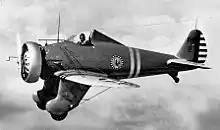 Boeing P-26
Boeing P-26 - P-27 – Consolidated
- P-28 – Consolidated
- P-29 – Boeing
- P-30 – Consolidated
- P-31 Swift – Curtiss
- P-32 – Boeing
- P-33 – Consolidated
- P-34 – Wedell-Williams (XP-34 Cancelled)
- P-35 – Seversky
- P-36 Hawk – Curtiss
- P-37 – Curtiss
- P-38 Lightning – Lockheed
- P-39 Airacobra – Bell
- P-400 - Royal Air Force Airacobra put into U.S. service before export
- P-40 Warhawk – Curtiss
- P-41 – Seversky (XP-41 Prototype)
- P-42 – Curtiss (XP-42 Prototype)
- P-43 Lancer – Republic
- P-44 Rocket – Republic
- P-45 – Bell (Initial designation of the P-39C or Model 13.)
- P-46 – Curtiss (XP-46 Prototype)
- P-47 Thunderbolt – Republic
- P-48 – Douglas (XP-48 Cancelled)
- P-49 – Lockheed (Cancelled)
- P-50 – Grumman (Cancelled)
- P-51 Mustang – North American
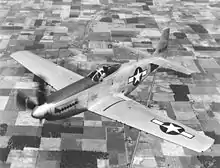 P-51H Mustang
P-51H Mustang - P-53 – Curtiss
- P-54 Swoose Goose – Vultee (XP-54 Prototype)
- P-55 Ascender – Curtiss (XP-55 Prototype)
- P-56 Black Bullet – Northrop (XP-56 Prototype)
- P-57 Peashooter – Tucker (Cancelled)
- P-58 Chain Lightning – Lockheed
- P-59 Airacomet – Bell
- P-60 – Curtiss (P-60 Prototypes, Cancelled)
- P-61 Black Widow – Northrop
- P-62 – Curtiss (XP-62 Prototype)
- P-63 Kingcobra – Bell
- P-64 – North American
- P-65 – Grumman (Cancelled)
- P-66 Vanguard – Vultee
- P-67 Bat – McDonnell (XP-67 Prototype)
- P-68 Tornado – Vultee (Cancelled)
- P-69 – Republic (XP-69 Prototype)
- P-70 Nighthawk – Douglas
- P-71 – Curtiss (XP-71 Cancelled)
- P-72 – Republic (XP-72 Prototype)
- P-73 – Hughes (officially never assigned)
- P-74 – skipped
- P-75 Eagle – Fisher
- P-76 – Bell (Prototype / Cancelled)
- P-77 – Bell (Prototypes)
- P-78 – North American (officially never assigned)
- P-79 – Northrop (XP-79 Prototype)
- F-80 Shooting Star – Lockheed
- P-81 – Convair (XP-81 Prototype)
- F-82 Twin Mustang – North American
- P-83 – Bell (Experimental)
- F-84 Thunderjet – Republic
- F-85 Goblin – McDonnell (XF-85 Prototype)
- F-86 Sabre – North American
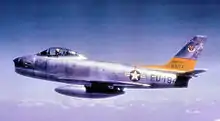 F-86F Sabre
F-86F Sabre - F-87 Blackhawk – Curtiss (XF-87 Prototype)
- F-88 Voodoo – McDonnell (Two Prototype)
- F-89 Scorpion – Northrop
- F-90 – Lockheed (XF-90 Prototype)
- F-91 Thunderceptor – Republic (XF-91 Prototype)
- F-92 – Convair (XF-92A Prototype)
- F-93 – North American (XF-93 Experimental)
- F-94 Starfire – Lockheed
- F-95 – North American (redesignated as F-86D Sabre)
- F-96 – Republic (redesignated as F-84F Thunderstreak)
- F-97 Starfire – Lockheed (redesignated as F-94C Starfire)
- F-98 Falcon – Hughes (redesignated as GAR-1, then AIM-4) (Air-to-Air Missile)
- F-99 BOMARC – Boeing (redesignated as IM-99, then CIM-10) (Surface-to-Air Missile)
- F-100 Super Sabre – North American
- F-101 Voodoo – McDonnell
- F-102 Delta Dagger – Convair
- F-103 – Republic (XF-103 Project)
- F-104 Starfighter – Lockheed
- F-105 Thunderchief – Republic
- F-106 Delta Dart – Convair
- F-107 – North American (Three Prototype)
- F-108 Rapier – North American (XF-108 Prototype)
- F-109 – designation was reserved for the F-101B,[7] and Bell D-188A, but never officially assigned (Proposed Experimental)
- F-110 Spectre – McDonnell Douglas (redesignated as F-4 in 1962)
- F-111 Aardvark – General Dynamics
 General Dynamics F-111
General Dynamics F-111 - Unofficial designations YF-112 and up were later assigned to "black" projects – see Fighter series in Unified System.
Fighter, Multiplace
- FM-1 Airacuda – Bell
- FM-2 – Lockheed
Observation, 1924–1942
- O-1 Falcon – Curtiss
- O-2 – Douglas
- O-3 Mohawk – Dayton-Wright
- O-4 – Martin
- O-5 – Douglas
- O-6 – Thomas-Morse
- O-7 – Douglas
- O-8 – Douglas
- O-9 – Douglas
- O-10 – Loening
- O-11 Falcon – Curtiss
- O-12 Falcon – Curtiss
- O-13 Falcon – Curtiss
- O-14 – Douglas
- O-15 – Keystone
- O-16 Falcon – Curtiss
- O-17 Courier – Consolidated
- O-18 Falcon – Curtiss
- O-19 – Thomas-Morse
- O-20 – Thomas-Morse
- O-21 – Thomas-Morse
- O-22 – Douglas
- O-23 – Thomas-Morse
- O-24 – Curtiss
- O-25 – Douglas
- O-26 – Curtiss
- O-27 – Fokker
- O-28 Corsair – Vought
- O-29 – Douglas
- O-30 – Curtiss
- O-31 – Douglas
- O-32 – Douglas
- O-33 – Thomas-Morse
- O-34 – Douglas
- O-35 – Douglas
- O-36 – Douglas
- O-37 – Keystone
- O-38 – Douglas
- O-39 Falcon – Curtiss
- O-40 Raven – Curtiss
- O-41 – Thomas-Morse
- O-42 – Thomas-Morse
- O-43 – Douglas
- O-44 – Douglas
- O-45 – Martin
- O-46 – Douglas
- O-47 – North American
- O-48 – Douglas
- O-49 Vigilant – Stinson (redesignated as L-1 in 1942)
- O-50 – Bellanca
- O-51 Dragonfly – Ryan
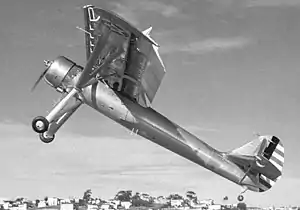 YO-51 Dragonfly
YO-51 Dragonfly - O-52 Owl – Curtiss
- O-53 Havoc – Douglas
- O-54 – Stinson
- O-55 – ERCO
- O-56 Ventura – Lockheed
- O-57 Grasshopper – Taylorcraft (redesignated as L-2 in 1942)
- O-58 Grasshopper – Aeronca (redesignated as L-3 in 1942)
- O-59 Grasshopper – Piper (redesignated as L-4 in 1942)
- O-60 – Kellett
- O-61 – Pitcairn
- O-62 Sentinel – Stinson (redesignated as L-5 in 1942)
- O-63 Grasshopper – Interstate (redesignated as XL-6 in 1942)
Observation amphibian, 1925–1948
- OA-1 – Loening
- OA-2 – Loening
- OA-3 Dolphin – Douglas
- OA-4 Dolphin – Douglas
- OA-5 – Douglas
- OA-6 – Consolidated
- OA-7 – Douglas
- OA-8 – Sikorsky
- OA-9 Goose – Grumman
- OA-10 Catalina – Consolidated
- OA-11 – Sikorsky
- OA-12 Duck – Grumman
- OA-13 Goose – Grumman
- OA-14 Widgeon – Grumman
- OA-15 Seabee – Republic
Photographic reconnaissance, 1930–1948 / Reconnaissance, 1948–1962
- F-1 – Fairchild
- F-2 Expeditor – Beechcraft
- F-3 Havoc – Douglas
- F-4 Lightning – Lockheed
- F-5 Lightning – Lockheed
- F-6 Mustang – North American
- F-7 Liberator – Consolidated
- F-8 Mosquito – de Havilland
- F-9 Flying Fortress – Boeing
- F-10 Mitchell – North American
- F-11 – Hughes
- F-12 Rainbow – Republic
- F-13 Superfortress – Boeing
- F-14 Shooting Star – Lockheed
- F-15 Reporter – Northrop
- R-11 – Hughes
- R-12 Rainbow – Republic
- R-16 Stratofortress – Boeing[8]
Reconnaissance-strike, 1960–1962
Both of the following aircraft are numbered in the B- (bomber) sequence.
- RS-70 Valkyrie – North American
- RS-71 Blackbird – Lockheed
Rotary wing 1941–1948 and helicopter 1948–1962
In 1941, the category letter R- was allotted for "rotary wing" aircraft, and this designation was used until the founding of the United States Air Force in 1947, at which point the category letter was changed to H-, for "helicopter". However, the original numbering sequence was retained.
- XR-1 – Platt-LePage
- XR-2 – Kellett
- XR-3 – Kellett
- R-4 Hoverfly – Sikorsky
- R-5/H-5 Dragonfly – Sikorsky
- R-6 Hoverfly II – Sikorsky
- XR-7 – Sikorsky
- XR-8 Kellett
- XR-9/XH-9 – Firestone
- XR-10/XH-10 – Kellett
- XR-11/XH-11 – Rotorcraft
- XR-12/XH-12 – Bell
- R-13/H-13 Sioux – Bell
- XR-14 – Firestone
- XR-15/XH-15 – Bell
- XR-16/XH-16 – Piasecki
- XR-17/XH-17 – Hughes/Kellett
- YH-18 – Sikorsky
- H-19 Chickasaw – Sikorsky
- XH-20 Little Henry – McDonnell
- H-21 Workhorse/Shawnee – Piasecki
- YH-22 – Kaman
- H-23 Raven – Hiller
- YH-24 – Seibel
- H-25 Army Mule – Piasecki
- XH-26 Jet Jeep – American Helicopter
- YH-27 Transporter – Piasecki
- XH-28 – Hughes
- H-29 – McDonnell
- YH-30 – McCulloch
- YH-31 – Doman
- YH-32 Hornet – Hiller
- XH-33 – Bell (redesignated as XV-3)
- H-34 Choctaw – Sikorsky
- XH-35 – McDonnell (redesignated as XV-1)
- H-36 – reserved for secret project LONG EARS
- H-37 Mojave – Sikorsky
- H-38 – reserved for secret project SHORT TAIL
- XH-39 – Sikorsky
- XH-40 – Bell
- YH-41 Seneca – Cessna
- XH-42 – Hughes
- H-43 Huskie – Kaman
- H-44 – reserved for secret project BIG TOM
- H-45 – reserved for secret project STEP CHILD
Supersonic/special test, 1946–1948
- XS-1 – Bell
- XS-2 – Bell
- XS-3 Stiletto – Douglas
- XS-4 Bantam – Northrop
- XS-5 – Bell
- This series was continued as the X (Experimental) series after 1948 – see X-series in Unified System.
Advanced Trainer, 1925–1948
- AT-1 – Huff-Daland
- AT-2 – Huff-Daland
- AT-3 – Boeing
- AT-4 Hawk – Curtiss
- AT-5 Hawk – Curtiss
- AT-6 Texan – North American (redesignated as T-6 in 1948)
- AT-7 Navigator – Beechcraft (redesignated as T-7 in 1948)
- AT-8 Bobcat – Cessna
- AT-9 Jeep – Curtiss-Wright
- AT-10 Wichita – Beechcraft
- AT-11 Kansan – Beechcraft (redesignated as T-11 in 1948)
- AT-12 Guardsman – Republic
- AT-13 Gunner – Fairchild
- AT-14 Gunner – Fairchild
- AT-15 Crewmaker – Boeing
- AT-16 – Noorduyn
- AT-17 Bobcat – Cessna
- AT-18 Hudson – Lockheed
- AT-19 Reliant – Stinson
- AT-20 Anson – Avro/Federal
- AT-21 Gunner – Fairchild
- AT-22 Liberator – Consolidated
- AT-23 Marauder – Martin
- AT-24 Mitchell – North American
Basic Combat, 1936–1940
- BC-1 – North American
- BC-2 – North American
- BC-3 – Vultee
Basic Trainer, 1930–1948
- BT-1 – Douglas
- BT-2 – Douglas
- BT-3 – Stearman
- BT-4 – Curtiss
- BT-5 – Stearman
- BT-6 – Consolidated
- BT-7 – Consolidated
- BT-8 – Seversky
- BT-9 – North American
- BT-10 – North American
- BT-11 – Aircraft Research
- BT-12 – Fleetwings
- BT-13 Valiant – Vultee
- BT-14 – North American
- BT-15 Valiant – Vultee
- BT-16 Valiant – Vultee
- BT-17 – Boeing-Stearman
Primary Trainer, 1925–1948
- PT-1 Trusty – Consolidated
- PT-2 Trusty – Consolidated
- PT-3 Trusty – Consolidated
- PT-4 Trusty – Consolidated
- PT-5 Trusty – Consolidated
- PT-6 – Consolidated
- PT-7 Pinto – Mohawk
- PT-8 – Consolidated
- PT-9 – Stearman
- PT-10 – Verville
- PT-11 – Consolidated
- PT-12 – Consolidated
- PT-13 Kaydet – Boeing-Stearman
- PT-14 – Waco
- PT-15 – St. Louis
- PT-16 – Ryan
- PT-17 Kaydet – Boeing-Stearman
- PT-18 Kaydet – Boeing-Stearman
- PT-19 Cornell – Fairchild
- PT-20 – Ryan
- PT-21 Recruit – Ryan
- PT-22 Recruit – Ryan
- PT-23 Cornell – Fairchild
- PT-24 Tiger Moth – de Havilland[9]
- PT-25 – Ryan
- PT-26 Cornell – Fairchild
- PT-27 Kaydet – Boeing-Stearman
Army, 1956–1962
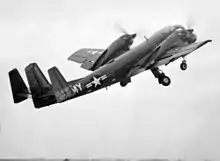
In 1956, the U.S. Army adopted a new, and relatively simple, designation system for its aviation assets. Aircraft were divided into three different types – 'A' for fixed-wing aircraft, 'H' for helicopters, or 'V' for V/STOL aircraft, and then were given a mission modifier, which, unlike the USAF system, came after the type code: 'C' for transports, 'O' for observation and reconnaissance aircraft, 'U' for utility types, and 'Z' for experimental aircraft. Aircraft types designated in this system were numbered sequentially.[10]
Airplane, Cargo, 1956–1962
- AC-1 Caribou – de Havilland Canada (redesignated as CV-2 in 1962, then C-7 in 1967)
- AC-2 Buffalo – de Havilland Canada (redesignated as CV-7 in 1962, then C-8 in 1967)
Airplane, Observation, 1956–1962
- AO-1 Mohawk – Grumman (redesignated as OV-1 in 1962)
- AO-2 Inflatoplane – Goodyear
- AO-3 Inflatoplane – Goodyear
Flying Platform, 1955–1956
- HO-1 Pawnee – Hiller (redesignated as VZ-1 in 1956)
- HO-2 – de Lackner Helicopters (redesignated as HZ-1 in 1956)
Helicopter, Cargo, 1956–1962
- HC-1A Sea Knight (redesignated as CH-46C in 1962)
- HC-1B Chinook (redesignated as CH-47A in 1962)
Helicopter, Observation, 1956–1962
Helicopter, Utility, 1956–1962
- HU-1 Iroquois – Bell (redesignated as UH-1 in 1962)
Helicopter, Experimental, 1956–1962
- HZ-1 Aerocycle – de Lackner Helicopters
Vertical Takeoff and Landing Research, 1956–1962
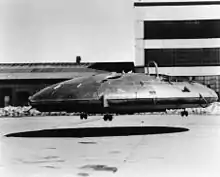
- VZ-1 Pawnee – Hiller
- VZ-2 – Vertol
- VZ-3 Vertiplane – Ryan
- VZ-4 Convertiplane – Doak
- VZ-5 Fledgling – Fairchild
- VZ-6 – Chrysler
- VZ-7-Curtiss-Wright
- VZ-8 Airgeep – Piasecki
- VZ-9 Avrocar – Avro Canada
- VZ-10 Hummingbird – Lockheed (redesignated as XV-4 in 1962)
- VZ-11 Vertifan – Ryan (redesignated as XV-5 in 1962)
- VZ-12 Kestrel – Hawker Siddeley (redesignated as XV-6 in 1962)
Unified System, 1962–present
A: Attack aircraft (for tactical air-to-surface mission)
- A-1 Skyraider – Douglas (formerly designated AD)
- A-2 Savage – North American (formerly designated AJ)
- A-3 Skywarrior – Douglas (formerly designated A3D)
- A-4 Skyhawk – Douglas (formerly designated A4D)
- A-5 Vigilante – North American (formerly designated A3J)
- A-6 Intruder – Grumman (formerly designated A2F)
- A-7 Corsair II – Ling-Temco-Vought
- A-8 – Skipped
- A-9 – Northrop (Losing contender for the AX competition)
- A-10 Thunderbolt II – Fairchild Republic (Winning contender for the AX competition)
- A-11 – Skipped
- A-12 Avenger II – McDonnell Douglas / General Dynamics (cancelled)
Non-sequential designations
- F/A-18A/B/C/D Hornet – McDonnell Douglas[11]
- F/A-18E/F Super Hornet – Boeing[11]
- EA-18G Growler - Boeing
- A-26 Invader - Douglas (originally designated A-26 in WW2, then B-26 when the Martin B-26 Marauder was obsolesced, reverted back to original A-26 in Vietnam era)
- A-29 Super Tucano – Embraer
- A-37 Dragonfly – Cessna (originally designated AT-37)
B: Bomber (for strategic air-to-surface mission)
Non-sequential designation
- B-21 Raider – Northrop
- FB-111A – General Dynamics (strategic bomber version of the F-111 used by Strategic Air Command, re-designated F-111G in 1989 after being re-assigned for tactical use)
C: Transport (Cargo)
- C-1 Trader – Grumman (formerly designated TF)
- C-2 Greyhound – Grumman
- C-3 – Martin 4-0-4 (formerly designated RM-1Z; Martin 4-0-4 airliners for use by the US Marine Corps and US Coast Guard)
- C-4 Academe – Gulfstream I (Used for training A-6 Intruder Naval Flight Officers.)
- C-5 Galaxy – Lockheed
- C-6 Ute – Beechcraft 90 King Air (re-designated U-21 Ute)
- C-7 Caribou – de Havilland Canada DHC-4 Caribou
- C-8 Buffalo – de Havilland Canada DHC-5 Buffalo
- C-9 Nightingale – McDonnell-Douglas DC-9
- C-10 Jetstream – Handley Page (USAF 68-10378/10388; were to be offset purchase for RAF F-111K, both cancelled)
- C-10 Extender – McDonnell-Douglas DC-10 (Winner of the KC-X competition (after cancellation of C-10 Jetstream, C-10 designation re-used)
- C-11 – Gulfstream II
- C-12 – Beechcraft
- C-14 – Boeing (AMST contender)
- C-15 – McDonnell-Douglas (AMST contender)
- C-16 – Skipped
- C-17 Globemaster III – Boeing
- C-18 – Boeing 707-320
- C-19 – Boeing 747-100
- C-20 – Gulfstream III (C-20A/B/C/D/E)
- C-20 – Gulfstream IV (C-20F/G/H/J)
- C-21 – Learjet 35
- C-22 – Boeing 727 (Air National Guard and National Guard Bureau personnel transports)
- C-23 Sherpa – Shorts (Military logistics transports for use in Europe and the US by the US Air Force and US Army)
- C-24 – Douglas DC-8-54F (A single example used for avionic trials as the EC-24A)
- C-25 - Boeing 747-200 (Presidential VIP transport)
- C-26 – Fairchild
- C-27 Spartan – Alenia G.222
- C-28 Titan – Cessna 404 Titan
- C-29 – British Aerospace BAe 125-800 (Airways and navaid checker)
- C-30 – Skipped
- C-31 Troopship - Fokker F27 Friendship
- C-32 - Boeing 757-200 (VIP transport)
- C-33 Boeing 747-400F (Proposed U.S. military transport version of the 747-400F)
- C-34 – Skipped
- C-35 – Cessna Citation Ultra
- C-36 – Skipped
- C-37 – Gulfstream V
- C-38 – Gulfstream G100 (formerly IAI Astra SPX)
- C-39 – Skipped
- C-40 Clipper – Boeing 737-700C (replacement for the C-9A Nightingale in USAF and C-9B Skytrain II in USN)
- C-41 - Construcciones Aeronáuticas SA C-212 series 200 Aviocar –[12]
- C-42 – Skipped
- C-43 – Skipped
- C-44 – Skipped
- C-45 – EADS (Losing KC-X contender[12])
- C-46 Pegasus – Boeing 767-2C (Winning KC-X contender)
Revived 1924-1962 sequence (2005-present)
- C-143 MRC2A – Bombardier Challenger CL-604 for US Coast Guard Medium Range Command and Control Aircraft[12]
- C-144 Ocean Sentry – CASA CN-235 300CG for US Coast Guard Medium Range Surveillance Maritime Patrol Aircraft (MRS MPA)[12]
- C-145 Skytruck - PZL M28 for special operations.
- C-146 - Dornier 328 for special operations.
- C-147 - De Havilland Canada Dash 8 as a jump platform.
Non-sequential designations
- KC-767 - Boeing KC-767 (Out of sequence designation selected by the U.S. Air Force (USAF) initially to replace older KC-135Es. In December 2003, the contract was frozen and later canceled due to corruption allegations).
- UC-880 – Convair (Out of sequence designation used for a single Convair 880 converted to a tanker to support trials from the NATC[13])
E: Special electronic installation
- E-1 Tracer – Grumman (Formerly WF)
- E-2 Hawkeye – Grumman (Formerly W2F)
- E-3 Sentry – Boeing
- E-4 "Nightwatch" – Boeing (Advanced Airborne Command Post)
- E-5 Eagle – Windecker
- E-6 Mercury – Boeing (TACAMO)
- E-7 – Designation proposed for EC-18B
- E-8 Joint Stars – Northrop Grumman
- E-9 Widget – de Havilland Canada
- E-10 MC2A – Boeing/Northrop Grumman
- E-11 – Bombardier/Northrop Grumman
F: Fighter
- F-1 Fury – North American (previously designated FJ-2, FJ-3, and FJ-4)
- F-2 Banshee – McDonnell (previously designated F2H)
- F-3 Demon – McDonnell (previously designated F3H)
- F-4 Phantom II – McDonnell Douglas (previously designated F4H and F-110)
- F-5 Freedom Fighter – Northrop
- F-6 Skyray – Douglas (previously designated F4D)
- F-7 Sea Dart – Convair (previously designated F2Y)
- F-8 Crusader – Vought (previously designated F8U)
- F-9 Cougar – Grumman (previously designated F9F-6)
- F-10 Skyknight – Douglas (previously designated F3D)
- F-11 Tiger – Grumman (previously designated F11F)
- F-12 – Lockheed (two-seat fighter version of the A-12 reconnaissance aircraft)
- F-13 – skipped
- F-14 Tomcat – Grumman
- F-15 A/B/C/D Eagle / F-15E Strike Eagle – McDonnell Douglas
- F-16 Fighting Falcon – General Dynamics / Lockheed Martin
- F-17 Cobra -- Northrop (YF-17 "Cobra" prototype)
- F-18A/B/C/D Hornet / F/A-18E/F Super Hornet – McDonnell Douglas
- F-19 – officially skipped
- F-20 Tigershark – Northrop (prototype)
- F-21 Kfir C-2 – Israel Aircraft Industries (for US Navy dissimilar combat training and aggressor training)
- F-22 Raptor – Lockheed Martin
- F-23 Black Widow II – Northrop / McDonnell Douglas (YF-23 prototype)
Non-sequential designations
- F-35 Lightning II – Lockheed Martin
- F-117 Nighthawk – Lockheed
Other Designations Note: Designations YF-110, YF-112 through YF-116, and YF-118 were captured foreign aircraft used for evaluation and aggressor training. They were given designations in sequence—based on chronology—with "black" project aircraft, continuing the pre-1962 F series.[14][15]
- YF-24 – (fictional?) classified project[14][16]
- YF-110 MiG-21s – Mikoyan-Gurevich
- YF-112 Su-22 – Sukhoi
- YF-113 MiG-23s – Mikoyan-Gurevich
- YF-113G – possible USAF "black project"[14]
- YF-114 MiG-17 – Mikoyan-Gurevich
- YF-115 – rumored designation of captured Su-7
- YF-116 – rumored designation of captured MiG-25
- F-117D Tacit Blue – Northrop
- YF-118 – rumored designation of MiG-29
- YF-121 – rumored "black project"[14]
G: Glider
- TG-1 – Schweizer
- TG-2 – Schweizer
- TG-3 – Schweizer[17]
- TG-4 – Schweizer[17]
- TG-5 – Schweizer
- TG-6 – Schweizer
- TG-7 – Schweizer[17]
- TG-8 – Schweizer
- TG-9 – Schleicher[17]
- TG-10 – Let[12][17]
- TG-11 – Stemme[17]
- TG-12 – Caproni Vizzola[12]
- TG-13 – Skipped
- TG-14 – Aeromot[12]
- TG-15 – Schempp-Hirth[12]
- TG-16 – DG Flugzeugbau
H: Helicopter
Unlike most other categories of aircraft, the introduction of the tri-service designation system in 1962 did not result in a wholesale redesignation of helicopters. While six types received new designations in the unified, "re-started" sequence, the original "H-" series of designations that started in 1948 was also continued, and no further types of rotorcraft have been designated in the "post-1962" system.
- H-1 Iroquois / "Huey" – Bell Helicopter (Formerly H-40 / HU-1)
- H-1 Cobra / SeaCobra / SuperCobra / Viper – Bell Helicopter
- H-2 Seasprite – Kaman Aircraft (Formerly HU2K)
- H-3 Sea King / "Jolly Green Giant" – Sikorsky Aircraft (Formerly HSS-2)
- H-4 – Bell Helicopter (Formerly HO-4)
- H-5 – Fairchild Hiller (Formerly HO-5)
- H-6 Cayuse / Little Bird – Hughes Helicopters / McDonnell Douglas / Boeing Helicopters (Formerly HO-6)
Continuation of 1948 sequence
- H-46 Sea Knight – Boeing Vertol
- H-47 Chinook – Boeing Vertol
- XH-48 – Bell (redesignated as UH-1F)
- XH-49 – Boeing Vertol (redesignated as XCH-46B)
- H-50 DASH – Gyrodyne
%252C_circa_in_1963_(4561400925).jpg.webp)
- XH-51 – Lockheed
- H-52 Sea Guard – Sikorsky
- H-53 Sea Stallion – Sikorsky
- H-54 Tarhe – Sikorsky
- H-55 Osage – Hughes
- H-56 Cheyenne – Lockheed
- H-57 Sea Ranger – Bell
- H-58 Kiowa – Bell
- XH-59 – Sikorsky
- H-60 Black Hawk – Sikorsky
- YH-61 – Boeing Vertol
- XH-62 – Boeing Vertol
- YH-63 Kingcobra – Bell
- H-64 Apache – Hughes
- H-65 Dolphin – Aérospatiale
- H-66 Comanche – Boeing/Sikorsky
- H-67 Creek – Bell
- H-68 Stingray – Agusta[12]
- H-69 – skipped
- H-70 Arapaho – Bell[12]
- H-71 Kestrel – Lockheed Martin[12]
- H-72 Lakota – Eurocopter[12]
- H-73 Koala – AgustaWestland
Non-sequential designations
- H-90 Enforcer - MD Helicopters
- H-92 - Sikorsky
- H-139 Grey Wolf - AgustaWestland
K: Tanker (dropped between 1977 and 1985)
No specialised types have been acquired to receive a stand-alone 'K for Tanker' designation; for aircraft modified for use as tankers, see the parent aircraft in the proper sequence.
O: Observation (Forward Air Control)
- O-1 Bird Dog Cessna Aircraft 14 December 1949 Formerly L-19
- O-2 Skymaster Cessna Aircraft January 1967
- O-3 "Quiet Star" Lockheed Missiles & Space 1969
- O-4 Wren Aircraft 1963
(Wren 460) Not proceeded with. - O-5 ARL de Havilland Canada 27 March 1975
(DHC-7) Formerly RC-7 - O-6 ARL Bombardier
P: Maritime patrol
- P-1 – Skipped
- P-2 Neptune – Lockheed Corporation (Formerly P2V)
- P-3 Orion / ARIES Lockheed Corporation (Formerly P3V; See also WP-3D Orion and EP-3 Aries)
- P-4 Privateer – Consolidated Aircraft (Formerly PB4Y-2K / P4Y-2K)
- P-5 Marlin – Glenn L. Martin Company (Formerly P5M)
- P-6 – Skipped
- P-7 – Lockheed Corporation (Cancelled)
- P-8 Poseidon – Boeing
- P-9 - Bombardier
Q: Unmanned Aerial Vehicle (UAV)
- Q-1 Predator – General Atomics
- Q-2 Pioneer – AAI Corporation/Israel Aircraft Industries
- Q-3 Dark Star – Lockheed Martin / Boeing
- Q-4 Global Hawk – Northrop Grumman
- Q-5 Hunter – Israel Aircraft Industries
- Q-6 Outrider – Alliant Techsystems
- Q-7 Shadow – AAI Corporation
- Q-8 Fire Scout – Northrop Grumman
- Q-9 Reaper/Altair – General Atomics (Originally "Predator B")
- Q-10 SnowGoose – MMIST
- Q-11 Raven – AeroVironment
- Q-12 - AeroVironment
- Q-13 – Skipped
- Q-14 Dragon Eye – AeroVironment
- Q-15 Neptune – DRS Technologies
- Q-16 T-Hawk – Honeywell
- Q-17 SpyHawk – MTC Technologies
- Q-18 Hummingbird Boeing
- Q-19 Aerosonde – AAI Corporation[12]
- Q-20 Puma – AeroVironment
- Q-21 Integrator – Boeing Insitu
- Q-22 AeroVironment
- Q-23 - NASC
- Q-24 - Kaman
- Q-25 Stingray - Boeing
- Q-26 - skipped
- Q-27 - Boeing
Non-sequential designations
- Q-58 - Kratos
- Q-170 Sentinel – Lockheed Martin
- Q-180 - Northrop Grumman
R: Reconnaissance
- TR-1 Dragon Lady – Lockheed Corporation
S: Anti-submarine warfare
- S-1 Skipped
- S-2 Tracker – Grumman Aircraft (Formerly S2F)
- S-3 Viking – Lockheed Corporation (Also called Shadow)
S: Spaceplane
The only designation in the "Spaceplane" series, the MS-1A shares a designation letter with the anti-submarine warfare category, and is perhaps unique among MDS identifiers as being assigned to a future, and currently not wholly defined, concept, as opposed to a specific project.[12][19]
T: Trainer
Despite the adoption of the unified Mission Designation System in 1962, only two aircraft were designated in the new series, both former Navy types. The old series continued in use until 1990, at which point a new series was started over at T-1, with the previous T-2 still being in use. However, the old series has still seen new designations being assigned. The next designation available in the 'T' series is T-54 or T-8, depending on which series is continued.
1948-present designations
- T-28 Trojan – North American
- T-29 Flying Classroom – Convair CV-240
- XT-30 – Douglas
- XT-31 – Fairchild
- T-32 – Convair CV-240
- T-33 Shooting Star – Lockheed
- T-34 Mentor – Beechcraft
- T-35 Buckaroo – Temco (foreign use only, none procured)
- XT-36 – Beechcraft/Canadair
- T-37 Tweet – Cessna
- T-38 Talon – Northrop
- T-39 Sabreliner – North American Saberliner
- T-40 Jet Star – Lockheed JetStar
- T-41 Mescalero – Cessna 172
- T-42 Cochise – Beechcraft Baron
- T-43 – Boeing 737-200
- T-44 Pegasus – Beechcraft KingAir
- T-45 Goshawk – McDonnell Douglas/BAE Systems
- XT-46 – Fairchild
- T-47 – Cessna Citation II
- YT-48 – Cessna
- T-48 MPATS[12] (cancelled)
- T-49 – Boeing[12] 707-331/382
- T-50 Golden Eagle – Korean Aerospace Industries (designation reserved, none procured)[12]
- T-51 – Cessna[12] 150
- T-52 – Diamond[20] DA40 Diamond Star
- T-53 – Cirrus SR20
1962 Sequence
- T-1 SeaStar – Lockheed Corporation (Formerly T2V)
- T-2 Buckeye – North American Aviation (Formerly T2J)
1990 Sequence
- T-1 Jayhawk – Raytheon / Hawker Beechcraft
- T-2 – Skipped (T-2 Buckeye was still in service)
- T-3 Firefly – Slingsby Aviation
- T-4 – Skipped
- T-5 – Skipped
- T-6 Texan II – Hawker Beechcraft
- T-7 Red Hawk - Boeing
U: Utility
- U-1 Otter – de Havilland Canada
- U-2 Dragon Lady – Lockheed Corporation
- U-3 Blue Canoe – Cessna
- U-4 Aero Commander – Aero Design
- U-5 Twin Courier – Helio
- U-6 Beaver – de Havilland Canada
- U-7 Super Cub Piper
- U-8 Seminole – Beechcraft
- U-9 Aero Commander – Aero Design
- U-10 Super Courier – Helio
- U-11 Aztec – Piper
- U-12 Skipped
- U-13 Skipped
- U-14 Skipped
- U-15 Skipped
- U-16 Albatross – Grumman
- U-17 Skywagon – Cessna
- U-18 Navion – North American/Ryan
- U-19 Sentinel – Stinson
- U-20 – Cessna
- U-21 Ute – Beechcraft
- U-22 – Beechcraft
- U-23 Peacemaker – Fairchild Hiller/Pilatus
- U-24 Courier – Helio
- U-25 Guardian – Dassault-Breguet
- U-26 Super Skywagon – Cessna
- U-27 Caravan – Cessna
- U-28 – Pilatus[12]
- U-38 Twin Condor – Schweizer
V: Vertical take-off/short take-off and landing (VTOL/STOL)
- V-1 – Grumman (Formerly AO-1)
- V-2 – de Havilland Canada (Formerly AC-1)
- XV-3 – Bell Helicopter (Formerly H-33)
- XV-4 Hummingbird – Lockheed Corporation (Formerly VZ-10)
- XV-5 Vertifan – Ryan Aeronautical (Formerly VZ-11)
- XV-6 Kestrel – Hawker Siddeley
- V-7 Buffalo – de Havilland Canada (Formerly AC-2, redesignated as C-8)
- XV-8 "Fleep" – Ryan Aeronautical (Designation later reused)
- V-8 Harrier – Hawker Siddeley
- XV-9 – Hughes Helicopters
- V-10 Bronco – Rockwell International / Boeing
- XV-11 Marvel – Parsons Corporation
- V-12 – Parsons Corporation (Cancelled, designation reused)
- XV-12 – Rockwell International
- V-13 – Skipped
- V-14 – Skipped to avoid confusion with X-14.[21]
- XV-15 – Bell Helicopter
- V-16 Advanced Harrier – McDonnell Douglas / British Aerospace (Not built; developed into AV-8B)
- V-17 – Assigned to a U.S. Army project but not used.[21]
- V-18 Twin Otter – de Havilland Canada
- V-19 – Assigned to a U.S. Navy project but cancelled.[21]
- V-20 Chiricahua – Pilatus Aircraft
- V-21 PACES – Airship Industries (Unconfirmed designation.[21])
- V-22 Osprey – Bell Helicopter / Boeing Helicopters
- V-23 Scout – Dominion Aircraft (Skytrader)
- XV-24 LightningStrike - Aurora
X: Special research
In addition to aircraft intended to support military operations, the unified system includes experimental craft designed to push the boundaries of aeronautical and aerospace knowledge. These aircraft are designated in the "X-series", which led them to become known as "X-planes". Only those with military sponsors are listed here.
- X-1 – Bell Aircraft, USAF, NACA
- X-2 "Starbuster" – Bell Aircraft, USAF
- X-3 Stiletto – Douglas Aircraft, USAF, NACA
- X-4 Bantam – Northrop, USAF, NACA
- X-5 – Bell Aircraft, USAF, NACA
- X-6 – Convair, USAF, AEC
- X-7 "Flying Stove Pipe" – Lockheed, Tri-service
- X-8 Aerobee – Aerojet, NACA, USAF, USN
- X-9 Shrike – Bell Aircraft, USAF
- X-10 – North American Aviation, USAF
- X-11 – Convair, USAF
- X-12 – Convair, USAF
- X-13 Vertijet – Ryan Aeronautical, USAF, USN
- X-14 – Bell Aircraft, USAF, NASA
- X-15 – North American Aviation, USAF, NASA
- X-16 – Bell Aircraft, USAF
- X-17 – Lockheed
- X-18 – Hiller Aircraft
- X-19 – Curtiss-Wright, Tri-service
- X-20 Dyna-Soar – Boeing, USAF
- X-21 – Northrop, USAF
- X-22 – Bell Aircraft, Tri-service
- X-23 PRIME – Martin Marietta, USAF (Note: Designation never officially assigned.[22])
- X-24 – Martin Marietta, USAF, NASA
- X-25 – Bensen, USAF
- X-26 Frigate – Schweizer, DARPA, US Army, USN
- X-27 – Lockheed
- X-28 Sea Skimmer – Osprey Aircraft, USN
- X-29 – Grumman, DARPA, USAF, NASA
- X-30 NASP – Rockwell, NASA, DARPA, USAF
- X-31 – Rockwell-MBB
- X-32 – Boeing, USAF, USN, RAF
- X-35 – Lockheed Martin, USAF, USN, RAF
- X-36 - McDonnell Douglas, NASA
- X-37 – Boeing, USAF, NASA
- X-39 – Unknown, USAF (Note: Designation never officially assigned.[22])
- X-40 – Boeing, USAF, NASA
- X-41 – Unknown, USAF
- X-42 – Unknown, USAF
- X-44 MANTA – Lockheed Martin, USAF, NASA
- X-45 – Boeing, DARPA, USAF
- X-46 – Boeing, DARPA, USN
- X-47A/X-47B – Northrop Grumman, DARPA, USN
- X-48 – Boeing, NASA
- X-49 Speedhawk – Piasecki Aircraft, US Army
- X-50 Dragonfly – Boeing, DARPA
- X-51 Waverider – Boeing, USAF
- X-53 – Boeing Phantom Works, NASA, USAF
- X-55 – Lockheed Martin Skunk Works, USAF
- X-56 – Lockheed Martin, USAF, NASA
- X-57 - NASA
- X-59 - Lockheed Martin, NASA
- X-60 - Generation Orbit Launch Services
- X-61 - Dynetics, DARPA
Z: Lighter-than-air
- Z-1 – Goodyear[18]
- Z-2 Sentinel – Westinghouse Airships
- Z-3 – American Blimp[12]
- Z-4 - Hybrid Air Vehicles
Un-designated foreign aircraft operated by the United States
- Airspeed Horsa – Airspeed Ltd
- Airspeed Oxford – Airspeed[9]
- Bristol Beaufighter – Bristol Aeroplane Company
- Boulton Paul Defiant – Boulton Paul Aircraft
- CAC Wirraway – Commonwealth Aircraft Corporation
- de Havilland Dominie – de Havilland[9]
- de Havilland Moth Minor – de Havilland.
- Diamond DA20 – Diamond Aircraft
- Hawker Hurricane – Hawker Aircraft[9]
- Heinkel HD 22 – Heinkel Flugzeugwerke
- Mil Mi-17 – Mil
- Miles Master – Miles Aircraft Ltd[9]
- Morane-Saulnier MS-234[23]
- Percival Proctor[9]
- Supermarine Spitfire[9]
- Westland Lysander
See also
- F/A-XX
- U.S. DoD aircraft designations table
- United States military aircraft serial numbers
- List of active United States military aircraft
- List of military aircraft of the United States (1909-1919)
- List of military aircraft of the United States (naval) (Pre-1962 designation aircraft only)
- United States military aero engine designations
- List of fighter aircraft
- List of maritime patrol aircraft
- List of airborne early warning aircraft
- List of tanker aircraft
- United States unified missile designation sequence
References
Citations
- AFR 66-11, AR 700-26, BUWEPSINST 13100.7, "Designating, Redesignating, and Naming of Military Aircraft", 18 September 1962
- "Airship AC-1 Lands At Field". The Airship Log. 1. Belleville, Illinois: Meyer & Farrell. 4 May 1923. p. 1 – via Newspapers.com.
- "RN-1 Zodiac Arrived at Scott Field". The Airship Log. 1 (1). Belleville, Illinois: Meyer & Farrell. 4 May 1923. p. 1 – via Newspapers.com.
- "Lockheed B-71 (SR-71)". National Museum of the United States Air Force. October 29, 2009. Archived from the original on October 4, 2013. Retrieved 2013-10-02.
- Andrade 1979, page 60
- Knaack, Marcelle Size (1978). Encyclopedia of US Air Force Aircraft and Missile Systems: Volume 1 (PDF). Washington, D.C.: Office of Air Force History. p. 1. Retrieved 10 December 2020.
- "HazeGray.org". rec.aviation.military FAQ, Part 4. Retrieved 2007-01-13.
- Andrade 1979, p. 162
- Office of History, Headquarters Third Air Force, United States Air Forces in Europe: Installations and USAAF Combat Units in the United Kingdom 1942–1945, Revised and Expanded Edition Archived 2011-09-24 at the Wayback Machine. October 1980; reprinted February 1985
- Chorney, Andrew. Systems of Designation, U.S. Army Aircraft, 1956–1962 System. U.S. Military Aircraft Designations 1911–2004
- Officially, the F/A-18 is designated in both the A-for-attack and F-for-fighter series.
- Parsch 2009, "DOD 4120.15-L"
- Chorney, Andrew. "U.S. Military Aircraft Designations 1911-2004". www.driko.org.
- Parsch, Andreas (2006-11-27). "Cover Designations for Classified USAF Aircraft". Designation-Systems.Net. Retrieved 2006-12-29.
- Fulghum, David A., "MiGs in Nevada", Aviation Week & Space Technology, November 27, 2006
- "Edwards AFB website". Col. Joseph A. Lanni, USAF biography. Archived from the original on 2005-03-18. Retrieved 2007-01-07.
- "94th Flying Training Squadron aircraft". Archived from the original on 2009-03-10.
- DOD 4120.15-L: Model Designation of Military Aerospace Vehicles, Department of Defense, Office of the Undersecretary of Defense (AT&L) (Defense Systems), May 12, 2004. Retrieved April 7, 2010.
- MS-1A, GlobalSecurity.org. Retrieved 2010-04-08.
- "Photo essay: Flight of a T-52A" U.S. Air Force.
- Parsch, Andreas. ""Missing" USAF/DOD Aircraft Designations". Designation-Systems.Net. Retrieved 2010-04-13.
- Parsch 2009, "Missing Designations"
- Baugher, Joseph F. 1930–1937 USAAS Serial Numbers
Sources
- Books
- Andrade, John M. (1979). U.S. Military Aircraft Designations and Serials Since 1909. Midland Counties Publications. ISBN 978-0-904597-22-6.
- Fahey, James C. (1946). U.S. Army Aircraft 1908–1946.
- Michael J.H. Taylor, ed. (1991). Jane's American Fighting Aircraft of the 20th Century. New York, NY: Mallard Press. ISBN 978-0-7924-5627-8.
